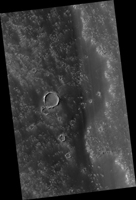
Map Projected Browse Image
Click on image for larger versionThis image is located on the southeastern flank of a volcano on Mars called Arsia Mons. On the eastern side of the image, the lobate margin of an old lava flow is visible among brighter tones.
The upstanding rims of several degraded impact craters are also visible. In the detailed cutout, we can see that the bright tones are erosion resistant outcrops, likely from dust that has accumulated and been sculpted by the wind. (The small crater on the left of the cutout is 70 meters across.)
Arsia Mons is a shield volcano with a relatively low slope and a massive caldera at its summit.
The map is projected here at a scale of 25 centimeters (9.8 inches) per pixel. (The original image scale is 25.2 centimeters [9.9 inches] per pixel [with 1 x 1 binning]; objects on the order of 76 centimeters [29.9 inches] across are resolved.) North is up.
The University of Arizona, in Tucson, operates HiRISE, which was built by Ball Aerospace & Technologies Corp., in Boulder, Colorado. NASA's Jet Propulsion Laboratory, a division of Caltech in Pasadena, California, manages the Mars Reconnaissance Orbiter Project for NASA's Science Mission Directorate, Washington.

